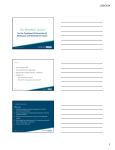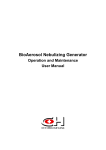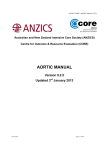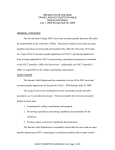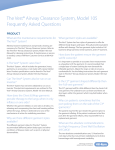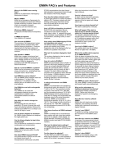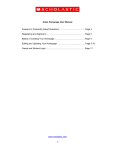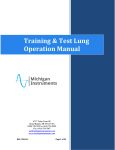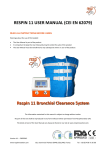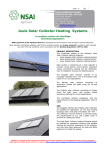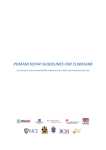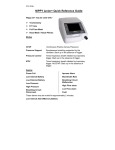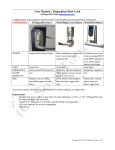Download Getting ready for use Cracking the tank
Transcript
Oxygen tanks Oxygen Delivery, Positive Pressure Breathing, Airway Clearance and Bronchial Hygiene Shawna Strickland, MEd, RRT-NPS, AE-C University of Missouri-Columbia Respiratory Therapy Program Getting ready for use Cracking the tank Applying regulator Opening the tank Checking PSI Applying oxygen device Storage and Transport Regulators Regulators have two functions; show PSI and control the flow of gas delivered to the patient Every kind of compressed gas has it’s own regulator that will only fit that particular kind of gas tank If it doesn’t fit don’t force it; it probably is for a different gas Every hospital will have its own standard for tank PSI requirements prior to use for therapy/transport – Always check your tank PSI prior to use Gas tanks are made from steel or aluminum They have a standard color coding system Caution: this system is different in other countries always check the label to be sure of the gas and its concentration Oxygen tanks are green Aluminum tanks are lighter and imprinted at the top near the collar 3AL Steel tanks are much heavier and imprinted at the top near the collar with 3AA or 3A Compressed Medical Gas Oxygen is 99% pure oxygen Cracking the tank Unscrew the top to expose the top of the tank Apply the specialized wrench to the tank and turn until you just hear the hiss of the gas escaping and then close. This is to blow any debris out of the tank connections that could damage the equipment or harm the patient. Applying the regulator The regulator should fit over the top of the tank and have two pins that will fit into receptacles on the tank Position the regulator with the pins in the receptacles and tighten down manually Then use the wrench to open the tank by turning at least two full turns and listen for a leak If you hear/feel a leak make sure the flow regulator is closed and listen again If the tank is still leaking close the tank, bleed out the gas in the regulator by turning the flow on until the PSI reaches zero, turn off the flow, remove the regulator and try again or get a different regulator that one may be broken New “grab and go” tanks are available that you simply turn off and on. Applying an oxygen device Device limitations Most devices now have quick connect ends to that you can attach them to threads or a “Christmas tree” Nasal Cannula If your device doesn’t you may need to make sure your regulator has a Christmas tree screwed onto the flow regulator or has the “nipple” style gas outlet Simple mask – The flow should never go above 6L. • The tubing cannot handle the increase in flow and it is damaging/drying to the patients nasal membranes. – The flow should never go below 6L. • There has to be enough continuous flow to flush out the patients CO2 so they don’t suffocate. Trach collar Your patient may have a prescribed amount of flow required during exercise, check their orders and set the flow. If they have no orders you can check what their flow rate is on their wall flow meter and set it based on that Oxygen delivery devices – Requires modification to use. You need to remove the adapter from the simple mask and insert it into the gas inlet tube on the collar – The flow should never go below 6L. • There has to be enough continuous flow to flush out the patients CO2 so they don’t suffocate. Wall source Oxygen flow meters Nasal Cannula (NC) Note: when putting in the nose make sure the prongs curve down. Simple Mask (SM) The flow rate is read at the center of the round ball Aerosol Trach Collar (ATC) Tank transport Tanks should be secured into an approved carrier during use. You should always pull the tank behind you never push it Tank storage • Turning off the tank – When finished take the patients delivery device off the tank and attach it to the wall flow meter ensuring accurate flow rate. – Close the tank and let the remaining gas bleed out of the regulator until the tank PSI reads zero ( you will hear the flow stop). – Close the flow regulator and remove the regulators if required. • You must bleed off the gas or it will damage the tanks regulator and cause inaccurate readings. Tank storage Tanks should be stored in approved storage racks or secured upright against the wall. If there is no rack place the tank gently on its side, out of the way, against the wall and find out where the tank should be placed. Never leave a tank lying against the wall or propped up against anything as this is unstable; if the tank falls it can cause serious damage/injury/even death. If a tank is empty it must be labeled as, EMPTY TANK DO NOT USE, with a tag prior to being put up. How long does the tank last? Every size tank holds a different amount of gas (obviously, bigger tanks last longer than smaller tanks) What do I need to figure out the duration? – Cylinder factor • E cylinder factor = 0.28 – Flow rate of oxygen to the patient – How full is the tank? Cylinder Duration Equation Your patient is wearing a nasal cannula with oxygen flowing at 2 LPM. He is using an E cylinder and it is full (2200 psig). Equation: 0.28 x 2200 2 LPM This tank will last 308 minutes… Try one on your own… Your patient is wearing a nasal cannula with oxygen flowing at 5 LPM. He is using an E cylinder and it is half full (1100 psig). How long will this tank last? – 5 hours and 8 minutes Oxygen Orders Remember that oxygen is a drug… – It must be prescribed by a physician. PRN Oxygen saturations via pulse oximeter – SpO2 Suctioning Suctioning Definition: – The removal of tracheobronchial and upper airway secretions Purpose: – To clear the airways of obstructions for improved gas exchange and prevent aspiration Important to remember: – This is always a sterile procedure when the patient has an endotracheal tube or tracheostomy tube Closed-Circuit Catheters Common features: – – – – Endotracheal or tracheostomy tube adaptor Suction catheter inside sterile sheath Thumb port Lavage port Popular because: – No disconnection from the ventilator (decreased VAP) – Reduced cost – Reduced exposure of HCP to infectious materials One-Use Sterile Catheters Sized in French (typically 6-14 Fr) Most catheters are 56 cm long Common features: – – – – – Thumb port to apply suction Side holes in the distal tip for plugging Distal tip is blunt and open Flexible Some have markings for length (cm) Complications of Suctioning Hypoxemia Cardiac arrhythmias Trauma to airway mucosa Atelectasis Contamination of lower airway Contamination of caregivers Increased intracranial pressure Suction Catheters Positive Pressure Breathing Manual Ventilation Indications: – Respiratory arrest or insufficient effort – Back up for patient on mechanical ventilators with an advanced airway Spontaneous Ventilation Ribs expand and diaphragm drops to create a negative pressure inside the thoracic cavity The lungs fill with air because the atmospheric pressure greater than the intrathoracic pressure Exhalation is passive (relying on chest recoil) Manual Resuscitators Three sizes: •Adult (25 kg and larger) •Pediatric (10-25 kg) •Neonatal (less than 10 kg) Resuscitation bags Self inflating bags are most common and have a one way valve that allows for exhalation while separating the exhaled gas from the oxygen reservoir. They are referred to as bag valve mask (BVM) or ambu bags. When entering a patients room you should always be aware of where their ambu bag is located or where to get one quickly in case of an emergency. Positive Pressure Ventilation Concept: – External pressure applied to the lung to move air – Exhalation is still passive Advantages: – Provide ventilation and oxygen for those who can’t (for whatever reason) do it themselves Disadvantages: – Over-inflation can cause many pulmonary and hemodynamic complications – Under-inflation doesn’t allow adequate ventilation and oxygenation Features of Manual Ventilators Oxygen tubing Oxygen reservoir (to provide more than 0.40 FiO2) Body of bag Lots of one-way valves to direct air flow Patient adaptor (to mask or tube) Exhalation port (do not occlude this!) Optional PEEP valve What to do Get patients attention – Shake their shoulder yell their name – Call for help – Perform a head tilt chin lift and look, listen, and feel for breathing – Get ambu bag and mask and hook up oxygen if available at 10-15 L (flush it if you have to) Mask positioning Mask are shaped like a teardrop and have a soft air filled cushion The point of the mask should hit the bridge of the nose and the base fit between the lower lip and chin Bagging Use your free hand to squeeze the resuscitator bag Check for chest wall rise to ensure air movement Reposition if needed (i.e. large resistance is met not an adequate seal) Do not completely empty the bag as you may “over inflate” and cause trauma to the lungs Follow BLS guidelines – 2 breathes every 30 cycles of chest compressions – If respiratory arrest only then 1 breath every 5-6 seconds or when patients has an effort Head tilt chin lift This is done by placing one hand on the forehead and another on the lower jaw and gently flexing the neck and lifting the chin This opens the airway and allows for adequate ventilation Sealing the mask In order to ventilate you must maintain a tight seal around the patients nose and mouth. This is done using the “E” “C” technique – Use the thumb and forefinger to make a “C” with the thumb on the apex of the mask and the forefinger at the base – Make and E with the remaining 3 fingers placed on the jaw line and thrust the jaw forward to keep the airway open Advanced airways • An advanced airway is an oral/nasal endotracheal tube (ETT) or tracheostomy • Remove the mask from the bag and the adapter should be universal and fit onto the patients ETT or the tracheostomy. • When an advanced airway is in place there is no interruption in bagging for chest compressions and the breaths are given at a rate of 1 every 6 seconds look for patient efforts and match their spontaneous rate . – Be sure to look for chest wall rise and cyclical fogging of the ETT Advanced Airways Artificial Airways REMEMBER: do not put excess tension or pressure on advanced airways as this may alter their position and result in accidental extubation What questions do I need to ask before choosing a bronchial hygiene therapy? 1. 2. 3. 4. Bronchial Hygiene Therapy 5. 6. 7. 8. Traditional Bronchial Hygiene Directed Cough Postural Drainage External manipulation of the thorax – Chest wall percussion – Chest wall vibration Does the patient have excessive mucus production? Does the patient have a weak, ineffective cough? Is the patient able to follow directions? Does the patient have a caregiver that can help administer therapy? Is the patient able to ambulate and/or change positions easily? What outcomes will be used to assess effectiveness of therapy? If the patient is currently receiving bronchial hygiene, when was the last time the appropriateness of the therapy was evaluated? Has anything in the patient’s condition changed since the last evaluation? Four Phases of Cough Postural Drainage Positioning New Methods of Bronchial Hygiene Positive expiratory pressure (PEP) – Acapella Flutter valve therapy Intrapulmonary percussive ventilation (IPV) High frequency chest wall oscillation (HFCWO) Use gravity to move secretions to the large airways so the patient can cough them out. PEP Therapy Contraindications to PEP Patients who are unable to tolerate the ↑ in work of breathing ICP > 20 mm Hg Hemodynamic instability Epistaxis Untreated pneumothorax This can be used with or without regular nebulizer therapy •Using it with nebulizer therapy achieves two goals at once When the patient exhales, positive pressure is created in the lungs. This pressure allows air to enter behind areas of mucus obstruction and keeps the airways open during exhalation. During exhalation, mucus is now able to move the mucus toward the larger airways and the patient can cough it out. Flutter Valve Cost of device: $50-60 Recent facial, oral or skull surgery or trauma Esophageal surgery Active hemoptysis Nausea Known or suspected tympanic rupture or other middle ear problem Flutter Valve Therapy When correctly, the effect is 3-fold: – Vibrations applied to the airway facilitate the loosening of secretions – The increase in bronchial pressure helps avoid air trapping – Expiratory air flows are accelerated and facilitate the upward movement of mucus 2 Stages of Flutter Technique Stage 1 Stage 2 – Loosening and mobilizing mucus – Using flutter will increase the pressure on exhalation and recruit lung units similar to the PEP device – Eliminating mucus – Cough or huff maneuver follows the flutter to help expel the secretions Flutter “Tips” Tilt is important – With the mouthpiece horizontal to the floor: • Tilt cone up or down to get maximal effect – Feel the patient’s chest and back for vibrations Clean the device on a regular basis by disassembling and soaking Acapella Similar to PEP but adds vibration therapy as well. Can be delivered with aerosol therapy. IPV Delivers rapid, high-flow bursts of air (or oxygen) into the lungs. At the same time, it delivers therapeutic aerosols (medications that might open the airways like Albuterol). Requires compressed gas to work. Who can use the IPV? Patients who can breathe on their own with a mouthpiece or mask Patients who are intubated and on a mechanical ventilator. Patients who have a tracheostomy and may or may not be on a ventilator. IPV Clinical Indications – – – – – Bronchiolitis Cystic fibrosis Chronic bronchitis Bronchiectasis Neuromuscular disorders – Emphysema Treatments typically last for about 15-20 minutes, depending on the individual patient and the medications that need to be given. HFCWO: “The Vest” •Patient wears vest and vest is secured with clasps or velcro. •Vest is filled with air and the air is vibrated. This causes “shaking” of the patient’s chest, which will loosen the mucus. •Designed for patient self-administration (home use). How do we know that this worked? Increased sputum production Improved breath sounds Improved chest x-ray Improved arterial blood gases Improved oxygenation (SpO2 or SaO2) Patient subjective response – Do you feel better? HFCWO: “The Vest” Pieces and parts: – Foot pedal (makes it go) – Patient vest is chosen based on patient size – Air pulse generator • We can adjust ventilator flow and speed of vibrations Treatments are usually about 30 minutes long. Most aerosolized medications can be administered at the same time.











